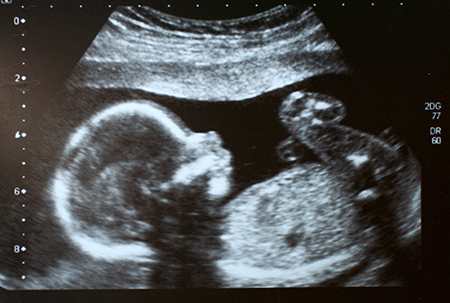Tracking your baby’s heartbeat. Before birth.
Every mother remembers what it’s like to hear her baby’s heartbeat for the first time.
Audible by stethoscope at 20 weeks’ gestation, the grape-sized organ pumps at 120 to 180 beats per minute — about twice as fast as ours. This vital sign plays a critical role in monitoring a baby’s health before, during and after birth.
For thousands of years, midwives provided comprehensive care for mothers and babies.

Labor and delivery in the age of pharaohs.
Dating from about 1900 – 1500 BC, the Egyptian Ebers Papyrus is one of the oldest medical manuscripts still in existence (University of Leipzig, Germany). Among the many conditions noted in the papyrus, i.e., medical care for pregnancy and delivery — how to hasten it — as well as prognostic indicators for the newborn.
Fast forward several millennia to 1956, when Yale University introduced the first fetal heart monitor. Since this time, technology and medicine have continued their march forward at a rapid beat.

How it’s done today.
Today, we’ve improved our ability to monitor fetal heart rate with a new system. Centricity Perinatal provides fetal heart rate monitoring tailored specifically for Epic. This system makes it easier for clinicians to track the fetal heartbeat, in utero and during birth.
Labor and delivery, the nursery and NICU — Centricity Perinatal provides a lot more visibility into a baby’s health before birth.
Providers can see all the information in one place, including viewing the baby’s heart rate history throughout the pregnancy. A bi-directional interface allows clinicians the flexibility of documenting directly on the fetal strip or in Epic, and making the information available for viewing.
This advanced fetal surveillance lets clinicians make faster, more informed decisions, enhancing patient care for infants. Remote monitoring of the fetal strip using Airstrip OB allows physicians the flexibility of viewing the fetal strip with pertinent information to tell the prenatal story and make immediate care decisions.
Making it easier.
Enhanced viewing means the fetal heart rate displays on the same screen as other critical information. It puts both mother and baby data in the same place, so clinicians don’t have to go back and forth to other medical records to see each one’s health data.
Auto-populating the baby’s Epic record with the mother’s pregnancy and delivery data — a significant time-saver that goes a long way in making it simpler. Plus, it comes at a significant cost savings.
Centricity Perinatal — making it easier to deliver healthy bundles of joy. A goal first tagged by ancient midwives lives on today.

